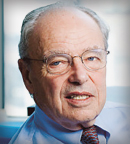In 1980, Paul G. Marks, MD, became the President and Chief Executive Officer of Memorial Sloan Kettering Cancer Center (MSK), the oldest and largest private cancer center in the world. Over his 19-year reign, he is credited with setting MSK on a more scientific course by encouraging innovative research and recruiting a wave of highly talented new investigators. Dr. Marks also directed the restructuring and expansion of MSK, which included the milestone unification with Memorial Hospital. His visionary efforts transformed MSK into the world-renowned comprehensive cancer center it is today. He led MSK for nearly 2 decades, leaving an indelible footprint of excellence in science and cancer care. Dr. Marks died on April 28, 2020. He was 93 years old.

Paul G. Marks, MD
A Mentor, a War, and a Medical Degree
Dr. Marks was born on August 16, 1926, in Ashland, a small economically depressed coal town in Schuylkill County, Pennsylvania. When he was 5 years old, his mother died, and his father became clinically depressed and disengaged in Dr. Marks’ life. After shuttling between relatives, Dr. Marks eventually relocated to the Brooklyn neighborhood of Bensonhurst, where he lived with his grandparents and attended public school.
During high school, Dr. Marks excelled in science, catching the eye of a teacher who took the bright young student under his wing. The teacher’s only son, a Cornell Medical School graduate, was killed in the battle of Guadalcanal. He encouraged Dr. Marks to go to medical school and pursue a profession where he could make a difference in the world. “My family had almost no resources to pay for school, so it took some convincing,” Dr. Marks recalled in an interview.
After graduating high school in 1942 at the top of his class, Dr. Marks entered Columbia University determined on becoming a doctor. But it was 1943 and WWII raged, so he applied for and was accepted into a naval officer training program. In October 1945, the war ended, and Dr. Marks received his undergraduate and medical degrees from Columbia, mostly financed by the GI Bill of Rights. Dr. Marks credited his college roommate, Josh Lederberg, a future Nobel Laureate, with sparking his interest in research. However, his 2-year research internship was interrupted by the Korean War, and, once again, the military needed soldiers.
In an interview with the Journal of Clinical Investigation, Dr. Marks told how the war was a propitious event in his career path. “At that time, the military was also recruiting for the new NIH’s Clinical Center Research Training Program, but the clinical research center was still being constructed, so it was suggested I walk into Arthur Kornberg’s lab. Arthur interviewed me, then he led me into the conference room and started putting stuff on the blackboard. He said, ‘Okay, this is what you’re going to work on.’ That was the start of my research career.”
Research Career Takes Off
After finishing his research stint at the National Institutes of Health (NIH), Dr. Marks returned to Columbia University in 1955, a fecund period of research, working in the laboratory of Nobel Laureate Jacques Monod. Over Dr. Marks’ research career, he led the discovery, testing, and approval of SAHA (suberoylanilide hydroxamic acid), the treatment of cutaneous T-cell lymphoma. He identified a genetic defect in globin synthesis as the basis of thalassemias, a sometimes-fatal group of anemias. His work helped to define the genetic basis for the differentiation of cells, particularly the way blood cells can become cancerous. Dr. Marks also played a pivotal role in the development of a pioneering approach to treating cancer, called cytodifferentiation, which led to the development of HDAC inhibitors for the treatment of lymphoma.
A Dean for 3 Years
In 1970, Dr. Marks was tapped to become the Dean of the Columbia University College of Physicians and Surgeons (P&S). Although ambivalent about taking on a large administrative position, Dr. Marks agreed. On his first day, he famously submitted his letter of resignation effective 3 years later. Over those 3 years, he spearheaded the fundraising effort that resulted in the Hammer Building. He also recruited some of the University’s most distinguished faculty, including Professor Eric R. Kandel, who would go on to win a Nobel Prize.During his tenure as Dean, Dr. Marks also served on President Nixon’s Cancer Panel, which was charged with developing cancer programs on national and school levels. He recalled that political experience as an “uphill battle to develop what I would consider cutting-edge programs.”
In 1979, Dr. Marks received a career-defining telephone call from Laurance Rockefeller, Chairman of the Board at MSK, offering Dr. Marks a position as the Center’s President. “I accepted because I thought the challenge was extremely interesting and I felt I could both work at an institutional level as well as at the laboratory bench in areas of cancer research and cancer care,” noted Dr. Marks in an interview.
Leaving a Legacy
Over his distinguished career, Dr. Marks was a member of the National Academy of Sciences, the National Academy of Medicine, the American Philosophical Society, and a Fellow of the American Academy of Arts and Sciences. To honor his contributions to science, President George H.W. Bush awarded Dr. Marks the National Medal of Science in 1991. Most recently, Dr. Marks received the Michael Pupin Medal for Service to the Nation in Science, Technology, or Engineering, bestowed by the Columbia Engineering Alumni Association.
In recognition to Dr. Marks’ many contributions to science and oncology, MSK established the Paul Marks Prize for Cancer Research, given each year to investigators who have made important contributions to cancer research early in their careers. His legacy is situated on East 66th Street in New York, the cancer center he led for 19 years.
Dr. Marks is survived by his wife of more than 60 years, Joan; his sons, Andrew and Matthew; his daughter Elizabeth; six grandchildren; two great-grandchildren; and a half-brother Laurence.

